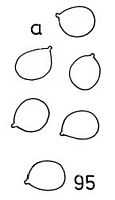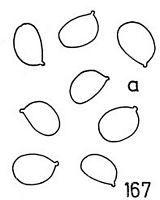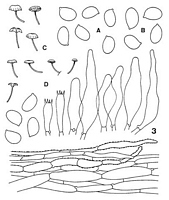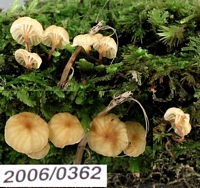|
 Xeromphalina leonina Xeromphalina leonina
SynonymsOmphalia leonina
Xeromphalina racemosa
Omphalia epichysium
Agaricus epichysium
BiostatusPresent in region - Indigenous. Non endemic
Images (click to enlarge)
Caption: 95-Xeromphalina racemosa [Omphalia epichysium]: a. spores. | 
Caption: 167-Xeromphalina racemosa [Omphalia leonina Massee]: a. spores. | 
Caption: A. spores (type); B. spores type of X. racemosa STEV. & TAYLOR); C. carpophores (ZT, 68/41); D. carpophores, spores, basidia, cheilocystidia, cuticle (ZT, 68/204) | 
Caption: FUNNZ: 2006/0362, See public note for more information
Owner: FUNNZ |  |
Article: Horak, E. (1980) [1979]. Xeromphalina and Heimiomyces in Indomalaya and Autralasia. Sydowia 32: 131-153.
Description: Description of fresh material collected in New Zealand: Pileus-10 mm, hemispheric or convex later becoming planoconvex or depressed and finally umbilicate at centre; yellow-brown to pale yellow-brown or cinnamon, paler towards striate incurved margin; hygrophanous, smooth, dry, tough, membranaceous. Lamellae (L 6-12, -3) crowded, broadly adnate or arcuate-decurrent; concolorous with pileus or paler, occasionally forked towards margin of pileus, edge even. Stipe-15 x-1 mm, cylindric or tapering towards base, central; pale yellow-brown above, reddish brown towards base, sometimes with concolorous strigose hairs and/or dark brown rhizomorphs at base; apex pruinose, smooth below, dry, tough, fistulose, single or cespitose in dense groups. Odour and taste not distinctive. Context pale yellow. Chemical reactions on pileus: KOH-brown.
Spores (5) 5.5-7 x 4-5 µm, ovate, smooth, hyaline, amyloid. Basidia 20 – 30 x 5 - 7 µm, 4-spored. Cheilocystidia 20 – 60 x 8-15 µm, fusoid or lageniform, membranes hyaline, thin-walled. Pleurocystidia absent. Caulocystidia like cheilocystidia or clavate, walls with red-brown (KOH) membranous and encrusting pigment. Cuticle a cutis of repent, cylindric or subfusoid hyphae (4- 8 µm diam.) membranes thin-walled, not gelatinised, encrusted with yellow-brown pigment. Clamp connections present.
Habitat: On rotten wood of broad-leaved trees (e. g. Nothofagus sp. in New Zealand).-New Zealand,. Papua New Guinea, England (type specimens adventitious on imported wood from New Zealand, Botanical Gardens, Kew).
Notes: W. COLENSO was the first who came across X. leonina (MASSEE). He collected this small agaric in New Zealand and the specimen was sent to Kew Herbarium labelled as "Omphalia epichysium PERS." (cp. material examined). Unaware of this misidentified record MASSEE (1898: 1. c.), a few years later, observed the same species in a greenhouse at Kew Botanical Garden where X. leonina (MASSEE) was found growing on wood imported from New Zealand. The "natural" area of distribution of this fungus, a common species on rotting logs (mostly Nothofagus spp.) in New Zealand, is not restricted to this region alone since (at least once) it was also recorded in Papua New Guinea. The rather large ovate spores are the most significant feature of this species.
Article: Massee, G.E. (1899) [1898]. The fungus flora of New Zealand. Transactions and Proceedings of the New Zealand Institute 31: 282–349 Wellington:.
Description: Pileus campanulate, slightly umbilicate, even, glabrous, very thin, extreme margin sometimes
slightly upturned, rich tawny-yellow, 4-8 mm. across; gills deeply decurrent, paler than the
pileus, very distant, thick; spores broadly elliptical, hyaline, smooth, 5 X 3 µ; stem about 2
cm. long, slender, expanding upwards into the pileus, polished, rich orange-brown, with
delicate tawny scurf at the base.
Notes: Omphalia leonina Massee (16 D) Fig. 14 = Xeromphalina racemosa Stevenson
and Taylor. This species was collected by Massee in Kew Gardens on a mossy
piece of wood imported from New Zealand. All micro- and macroscopical
characters correspond with X. racemosa which grows in New Zealand preferably
on rotten wood of Nothofagus. Spores oval, hyaline, amyloid, smooth, 5-6 X 3.5-4.5 µ.
Article: Horak, E. (1971). A contribution towards the revision of the Agaricales (Fungi) from New Zealand. New Zealand Journal of Botany 9(3): 403-462 (http://www.rsnz.org/publish/abstracts.php).
Notes: Omphalia leonina Massee (16 D) Fig. 14 = Xeromphalina racemosa Stevenson
and Taylor. This species was collected by Massee in Kew Gardens on a mossy
piece of wood imported from New Zealand. All micro- and macroscopical
characters correspond with X. racemosa which grows in New Zealand preferably
on rotten wood of Nothofagus. Spores oval, hyaline, amyloid, smooth, 5-6 X 3.5-4.5 µ.
Article: Stevenson, G. (1964). The Agaricales of New Zealand: V. Kew Bulletin 19(1): 1-59.
Description: Pileus 2-4 mm diam., cinnamon, darker at centre and with dark striations. Gills decurrent, concolorous, distant, about 10 in number. Stipe 4-5 x 0.25-0.5 mm cinnamon, thickest where gills are attached, with strigose ball of spreading hyphae at base, attached to dark brown, branching rhizomorphs. Spores 7 x 4.5 µm, amyloid. Hyphae of cap and stipe pseudo-amyloid. Cheilocystidia 30-40 x 3-8 µm hair-like to bottle-shaped (Fig. 58).
Habitat: In well-rotted log in Nothofagus forest, Butterfly, Wellington, 8.4.1961, G. M. Taylor (type).
Article: Horak, E. (1971). A contribution towards the revision of the Agaricales (Fungi) from New Zealand. New Zealand Journal of Botany 9(3): 403-462 (http://www.rsnz.org/publish/abstracts.php).
Notes: Omphalia epichysium (Persoon) (6) Fig. 7 = Xeromphalina racemosa Stevenson
The original collection (COLENSO b 138, on logs in woods) is well preserved
and there are no problems in identifying the specimen. The spores are strongly
amyloid, oval, smooth, 4.5-5.5 X 4-4.5(5) µ and only slightly smaller than those
of the type.
|